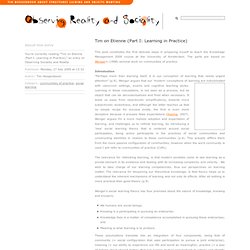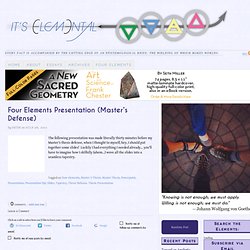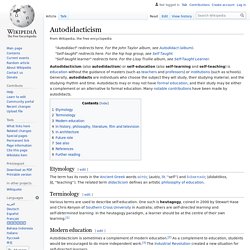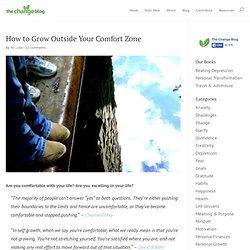

Hacking Knowledge: 77 Ways to Learn Faster, Deeper, and Better. If someone granted you one wish, what do you imagine you would want out of life that you haven’t gotten yet?

For many people, it would be self-improvement and knowledge. Newcounter knowledge is the backbone of society’s progress. The lesson you never got taught in school: How to learn! A paper published in Psychological Science in the Public Interest evaluated ten techniques for improving learning, ranging from mnemonics to highlighting and came to some surprising conclusions.

The report is quite a heavy document so I’ve summarised the techniques below based on the conclusions of the report regarding effectiveness of each technique. Lifelong Learning. The art of autodidacticism - Stellarmine. Education Through Leadership. Executive Leadership & Management Training - MeetTheBoss TV. Observing Sociality and Reality » Blog Archive » Tim on Etienne (Part I: Learning in Practice) This post constitutes the first delicate steps in preparing myself to teach the Knowledge Management 2009 course at the University of Amsterdam.

The parts are based on Wenger’s (1998) seminal work on communities of practice. Introduction “Perhaps more than learning itself, it is our conception of learning that needs urgent attention” (p.9). 2300110305002.png (Image PNG, 1329x792 pixels) - Redimensionnée (83%) Creating Blogs and Websites. This page is where you can find resources related to my presentations about creating effective blogs and websites to complement instruction.

How to create a Blogger blog. How to turn on comment moderation in Blogger. How to add or subtract contributors to your Blogger blog. How to create an Edublogs blog. How to create a Wordpress.com blog. How to create a Posterous blog. The Basics of Creating and Editing a Wikispaces Wiki.More, including a video tutorial, about using Wikispaces. Creating a Google Sites website. Ten Options for Creating Websites. Intelligence Forms. Learning Theories. The 6 types of Questions your Students Need to Know about. Learning is all about asking questions and finding answers to them.

An inquisitive mind is one that goes beyond the status quo and probes deep below surface meanings. To foster such kind of thinking inside our classroom requires some hard work and a serious investment in time and efforts. We, as teachers and educators, need to prepare the right environment where inquisitive minds can nourish and grow. Study Guides and Strategies. Four Elements Presentation (Master’s Defense) — It's Elemental. The following presentation was made literally thirty minutes before my Master’s thesis defense, when I thought to myself, hey, I should put together some slides!

Luckily I had everything I needed already… you’ll have to imagine how I skilfully (ahem…) wove all the slides into a seamless tapestry. Tagged as: four elements, Master S Thesis, Master Thesis, Powerpoint, Presentation, Presentation Ppt, Slides, Tapestry, Thesis Defense, Thesis Presentation. Study matrix.pdf. Category:Alternative education.
Thinking Methods. Daniel Dennett Offers Tools For Thinking. Category:Learning methods. Thinking tools. Keynote. Autodidacticism. Independent education without the guidance of masters Autodidacticism (also autodidactism) or self-education (also self-learning and self-teaching) is education without the guidance of masters (such as teachers and professors) or institutions (such as schools).

Generally, autodidacts are individuals who choose the subject they will study, their studying material, and the studying rhythm and time. Autodidacts may or may not have formal education, and their study may be either a complement or an alternative to formal education. Many notable contributions have been made by autodidacts. How to Grow Outside Your Comfort Zone. Are you comfortable with your life?

Are you excelling in your life? “The majority of people can’t answer “yes” to both questions. They’re either pushing their boundaries to the limits and hence are uncomfortable, or they’ve become comfortable and stopped pushing.” – Charlie Gilkey “In self growth, when we say you’re comfortable, what we really mean is that you’re not growing. Know thyself. Artist's impression of original text inscribed in Temple of Apollo at Delphi.

Photo of the Stone of 12 Angles, Cusco, Peru. A stained glass window in a public building in Ludwigshafen, Germany with the contracted version γνῶθι σαυτόν. The maxim, or aphorism, "know thyself" has had a variety of meanings attributed to it in literature. Ralph Dumain: The Autodidact Project. Knowledge building. The Knowledge Building (KB) theory was created and developed by Carl Bereiter and Marlene Scardamalia for describing what a community of learners needs to accomplish in order to create knowledge.

The theory addresses the need to educate people for the knowledge age society, in which knowledge and innovation are pervasive.[1] Overview[edit] Scardamalia & Bereiter distinguish between Knowledge building and learning. 14 websites to make you a more intelligent person. Motivation. Motivation has been shown to have roots in physiological, behavioral, cognitive, and social areas.
Motivation may be rooted in a basic impulse to optimize well-being, minimize physical pain and maximize pleasure. It can also originate from specific physical needs such as eating, sleeping or resting, and sex. Motivation is an inner drive to behave or act in a certain manner. These inner conditions such as wishes, desires and goals, activate to move in a particular direction in behavior. Tree. Looking for Strategies and Activities? Click Here! The tree can act as a metaphor to help us see the relationship between theory and practice in second language learning and teaching. The ROOTS represent concepts and theories to be considered in teaching in general and in second language acquisition in particular.
The TRUNK represents what the student brings to the learning context – their attitudes, learning styles and intelligences, their cognitive and affective abilities. The BRANCHES represent what the student needs to learn (listening, speaking, reading, writing, and culture). Free PDF: Co-Creating Knowledge Online. Co-Creating Knowledge Online is the second booklet in a series of Internet field guides (formerly “critical guides”) I have developed for community artists and culture makers. It is for those who are interested in better utilising the Internet to connect, share, and make new knowledge. It builds on the premise that people have become increasingly networked as individuals rather than in groups, and that these new ways of connecting enable new modes of peer-to-peer co-creation. It is an attempt to translate my PhD research findings for community arts practitioners, and was inspired by the practices of CuriousWorks.
The booklet is available as a free PDF in beta. If you download it, please leave a comment on this post regarding why the booklet is of interest to you. 6 thinking hats. Portal:Thinking. Logic. Bloom's Taxonomy. Bloom's wheel, according to the Bloom's verbs and matching assessment types. The verbs are intended to be feasible and measurable.
Bloom's taxonomy is a classification of learning objectives within education. It is named for Benjamin Bloom, who chaired the committee of educators that devised the taxonomy, and who also edited the first volume of the standard text, Taxonomy of Educational Objectives: The Classification of Educational Goals. Bloom's Taxonomy-Learning in Action. Bloom’s Taxonomy: The 21st Century Version. So much have been written about Bloom’s taxonomy; one click in a search engine will flood your page with hundreds of articles all of which revolve around this taxonomy.
Only few are those who have tried to customize it to fit in the 21st century educational paradigm. As a fan of Bloom’s pedagogy and being a classroom practitioner, I always look for new ways to improve my learning and teaching, and honestly speaking , if you are a teacher/ educator and still do not understand Bloom’s taxonomy then you are missing out on a great educational resource.
The following article is a summary and a fruit of my long painstaking research in the field of Bloom’s taxonomy. The purpose is to help teachers grow professionally and provide them with a solid informational background on how to better understand and apply Bloom’s taxonomy in classrooms in the light of the new technological advances and innovations. The Differentiator. Bloom (Krathwohl and Anderson) and Web 2.0. Le Blended Learning. Framework for a learning journey design workshop, 25/01/11, Inspires Learning - Robert O'Toole. The Future of Education - Charting the Course of Teaching and Learning in a Networked World. Jiddu Krishnamurti. Didactique professionnelle. Je pensais qu’en atelier j’aurais plus de temps libre pour donner des explications et faire des démonstrations aux élèves. Malheureusement, ce ne fut pas le cas. Pendant que je travaillais avec un élève, j’en avais trois autres qui venaient me demander quoi faire, deux autres qui me demandaient si ce qu’ils avaient fait était correct, trois autres qui avaient décidé de faire autre chose que ce que j’avais demandé et la balance restait à leur établi à ne rien faire.
À travers tout cela, je tentais de donner mes explications jusqu’au moment ou j’entendais un outil faire des sons bizarres. Je courrais pour aller voir et donner les indications, réparer l’outil ou l’ajuster pendant que le dernier élève expliquait aux autres sa frustration d’avoir été abandonné par le prof pendant son explication.
Il fallait faire quelque chose. J’ai compris, avec le temps, que le travail en atelier faisait partie d’un tout dont il fallait synchroniser chacune des composantes pour pouvoir arriver.